Definition
Protein synthesis is process in which polypeptide chains are formed from coded combinations of single amino acids inside the cell. The synthesis of new polypeptides requires a coded sequence, enzymes, and messenger, ribosomal, and transfer ribonucleic acids (RNAs). Protein synthesis takes place within the nucleus and ribosomes of a cell and is regulated by DNA and RNA.

Protein Synthesis Steps
Protein synthesis steps are twofold. Firstly, the code for a protein (a chain of amino acids in a specific order) must be copied from the genetic information contained within a cell’s DNA. This initial protein synthesis step is known as transcription.
Transcription produces an exact copy of a section of DNA. This copy is known as messenger RNA (mRNA) which must then be transported outside of the cell nucleus before the next step of protein synthesis can begin.
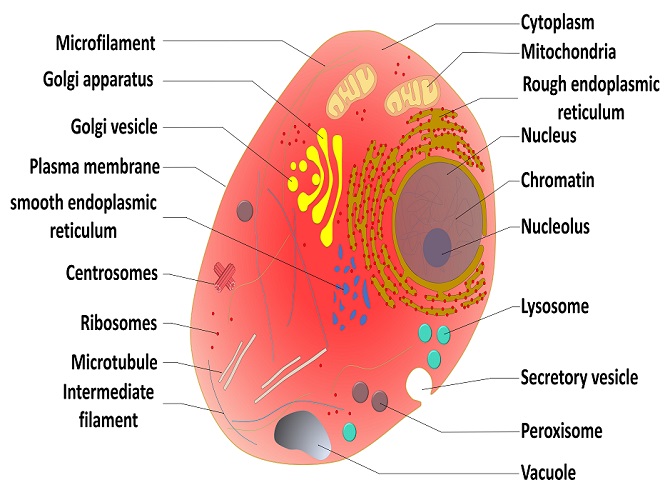
The second protein synthesis step is translation. Translation occurs within a cell organelle called a ribosome. Messenger RNA makes its way to and connects with the ribosome under the influence of ribosomal RNA and enzymes. Transfer RNA (tRNA) is a molecule that carries a single amino acid and a coded sequence that acts like a key. This key fits into a specific sequence of three codes on the mRNA, bringing the correct amino acid into place. Each set of three mRNA nitrogenous bases is called a codon.
Translation and transcription will be explained in much more detail further on. In order to keep protein synthesis simple, we first need to know the basics.
Polypeptides and Proteins
The result of protein synthesis is a chain of amino acids that have been attached, link by link, in a specific order. This chain is called a polymer or polypeptide and is constructed according to a DNA-based code. You can picture a polypeptide chain as a string of beads, with each bead playing the part of an amino acid. The order in which the beads are strung are copied from instructions in our DNA.

When speaking of protein synthesis it is important to make a distinction between polypeptide chains and proteins. All proteins are polypeptides but not all polypeptides are proteins; however, both proteins and polypeptides are composed of amino acid monomers.
The difference between a protein and a polypeptide is the form. Smaller chains of amino acids – usually less than forty – remain as single-chain strands and are called polypeptides. Larger chains must package themselves more tightly; they fold into fixed structures – secondary, tertiary, and quaternary. When a polypeptide chain folds, it is called a protein.
Polypeptide chains are formed during the translation process of protein synthesis. These polypeptides may or may not fold into proteins at a later stage. However, the term ‘protein synthesis’ is used even in the scientific community and is not incorrect.
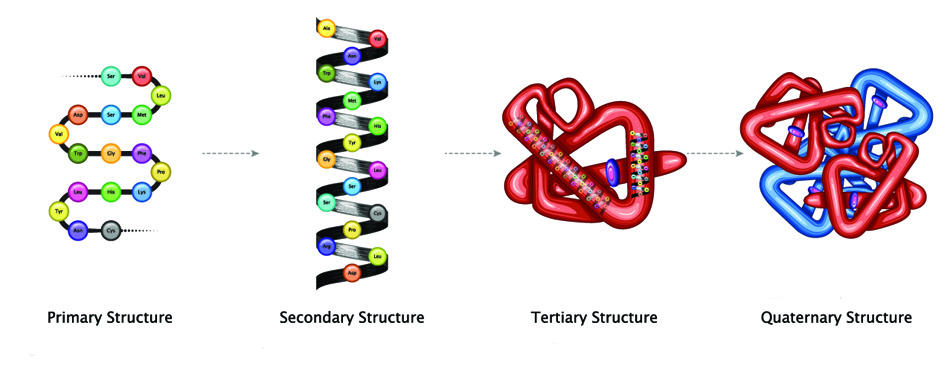
Understanding protein synthesis is easy when we imagine our DNA as a recipe book. This book lists the instructions that show a cell how to make every tiny part of every system, organ, and tissue within our bodies. All of these individual parts are polypeptides. From the keratin in your hair and fingernails to the hormones that run through your bloodstream, polypeptides and proteins are the foundation stones of every structure. Our DNA does not code for lipids or carbohydrates – it only codes for polypeptides.
The enzyme RNA polymerase opens the DNA recipe book that sits inside the cell nucleus. It uses certain pieces of code as bookmarks to find the right page. This recipe book is written in a foreign language – mRNA copies what is written without understanding it. The recipes are translated into a language that other molecules can decipher at a later stage. The translators are ribosomes and tRNA. They read the recipe and can collect the right ingredients and, in the correct order, make the finished polypeptide product.

DNA Sequences
In the nucleus, two strands of DNA are held together by nitrogenous bases (also called nucleobases or bases). Four bases – cytosine, guanine, adenine, and thymine – form the letters of the words in the DNA recipe book.
One strand of DNA holds the original code. If the instructions of this code are carefully followed, a specific correct polypeptide can be assembled outside the nucleus. The second DNA strand – the template strand – is a mirror image of the original strand. It must be a mirror image as nucleobases can only attach to complementary partners. For example, cytosine only ever pairs with guanine and thymine only pairs with adenine.
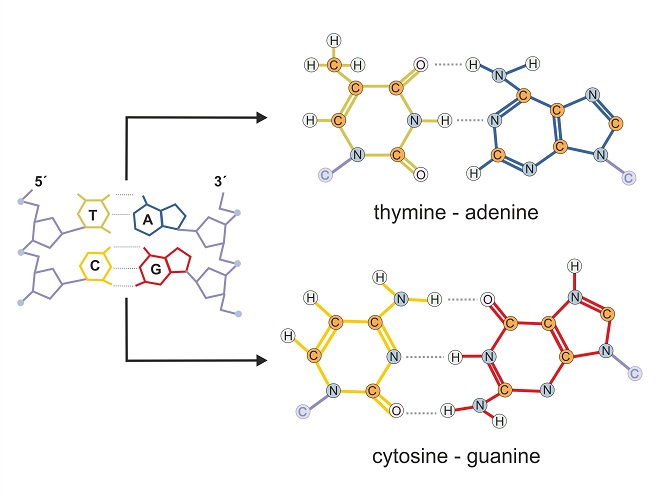
You will probably have seen codes such as CTA, ATA, TAA, and CCC in various biology textbooks. If these are the codons (sets of three bases) of the original strand of DNA, the template strand will attach to these using their partners. So using the given examples, template DNA will attach to the original DNA strand using GAT, TAT, ATT, and GGG.
Messenger RNA then copies the template strand. This means it ends up creating an exact copy of the original strand. The only difference is that mRNA replaces thymine with a base called uracil. The mRNA copy of the template strand using the given examples would read CUA, AUA, UAA, and CCC.
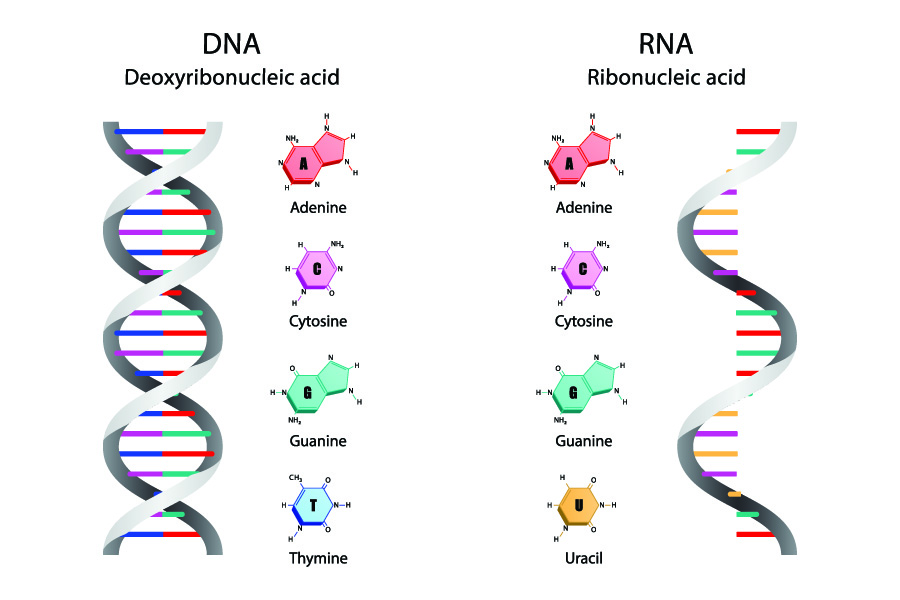
These codes can be read by transfer RNA outside the nucleus; the recipe can be understood by a molecule that does not fully understand the language used in the original (it does not understand thymine, only uracil). Transfer RNA helps to bring the right parts to the assembly line of the ribosome. There, a protein chain is constructed that matches the instructions in the original DNA strand.
Protein Synthesis Contributors
To make the copied stretch of code (transcription) we need enzymes called RNA polymerases. These enzymes gather free-floating messenger RNA (mRNA) molecules inside the nucleus and assemble them to form the letters of the code. Each letter of DNA code has its own key and each new letter formed by mRNA carries a lock that suits this key, a little like tRNA.
Notice that we are talking about letters. This is important. Inside the nucleus, the DNA code is not understood, simply copied down – transcribed. Understanding the code by spelling out the words formed by these letters – translating – happens at a later stage.

RNA polymerase must find and bring over the appropriate mRNA molecule for each nitrogenous base on the template strand. Selected mRNA molecules link together to form a chain of letters. Eventually, these letters will spell out the equivalent of a phrase. Each phrase represents a specific (polypeptide) product. If the recipe is not exactly followed, the final product might be completely different or not work as well as it should.
Messenger RNA has now become the code. It travels to the next group of important contributors that work as manufacturing plants. Ribosomes are found outside the cell nucleus, either in the cell cytoplasm or attached to the rough endoplasmic reticulum; it is ribosomes that make the endoplasmic reticulum ‘rough’.
A ribosome is split into two parts and the strand of mRNA runs through it like ribbon through an old-fashioned typewriter. The ribosome recognizes and connects to a special code at the start of the translated phrase – the start codon. Transfer RNA molecules enter the ribosome, bringing with them individual ingredients. As with all of these processes, enzymes are required to make the connections.

If each mRNA codon has a lock, tRNA possesses the keys. The tRNA key for an mRNA codon is called an anticodon. When a tRNA molecule holds the key that matches a three-nucleobase code it can open the door, drop off its load (an amino acid), and leave the ribosome factory to collect another amino acid load. This will always be the same type of amino acid as the anticodon.
Messenger RNA shifts along the ribosome as if on a conveyor belt. At the next codon another tRNA molecule (with the right key) brings the next amino acid. This amino acid bonds to the previous one. A chain of bonded amino acids begins to form– a polypeptide chain. When completed, this polypeptide chain is an accurate final product manufactured according to the instructions in the DNA recipe book. Not a pie or a cake but a polypeptide chain.
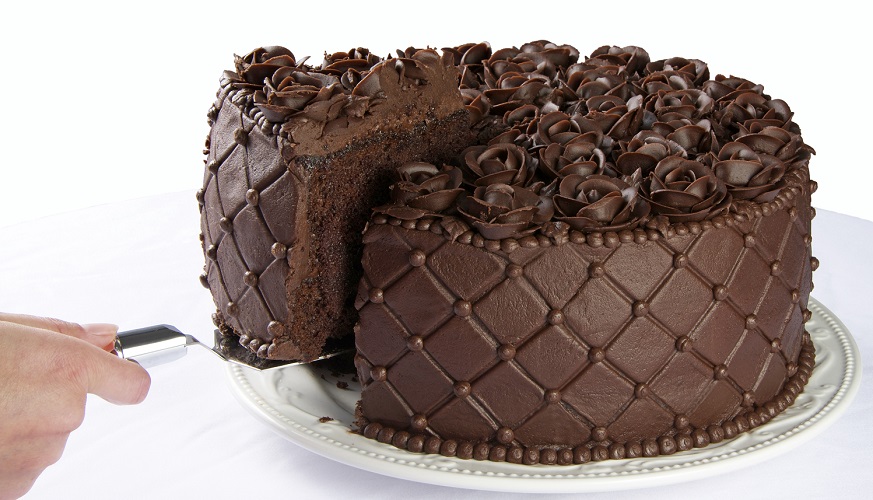
The end of the mRNA code translation process is signaled by a stop codon. Start and stop codons do not code for amino acids but tell the tRNA and ribosome where a polypeptide chain should begin and end.
The finished product – the newly synthesized polypeptide – is released into the cytoplasm. From there it can travel to wherever it is needed.
Site of Protein Synthesis
The site of protein synthesis is twofold. Transcription (copying the code) occurs within the cell nucleus where DNA is located. Once the mRNA copy of a small section of DNA has been made it travels through the nuclear pores and into the cell cytoplasm. In the cytoplasm, the strand of mRNA will move towards a free ribosome or one attached to the rough endoplasmic reticulum. Then the next step of protein synthesis – translation – can begin.
New Roles for Ribosomes
The average mammalian cell contains more than ten million ribosomes. Cancer cells can produce up to 7,500 ribosomal subunits (small and large) every minute. As a polypeptide-producing factory, the existence, development, and function of every living organism depends on the ribosome.

It was previously thought that eukaryotic ribosomes only played effector roles in protein synthesis (caused an effect – a new protein). However, recent research now shows that ribosomes also regulate the translation process. They play a part in deciding which proteins are manufactured and in what quantities. The success and results of translation depend on more than the availability of free amino acids and enzymes – they also depend on the quality of the ribosomes.
Transcription in Protein Synthesis
The transcription process is the first step of protein synthesis. This step transfers genetic information from DNA to the ribosomes of the cytoplasm or rough endoplasmic reticulum. Transcription is divided into three phases: initiation, elongation and termination.

Initiation
Initiation requires two special protein groups. The first group is transcription factors – these recognize promoter sequences in the DNA. A promoter sequence is a section of code found at the start of a single gene that shows where the copying process should begin and in which direction this code should be read. A promoter works a little like the start codon on mRNA.
The second protein group necessary for transcription initiation consists of DNA-dependent RNA polymerases (RNAPs). An RNA polymerase molecule binds to the promoter. Once this connection has been made, the double-stranded DNA unwinds and opens (unzips).

Connected bases keep the two strands of DNA in a double-helix form. When the two strands unzip, the individual and now unpartnered bases are left exposed. The unzipping process is repeated along the stretch of DNA by RNAPs until the transcription stop point or terminator is reached. Intitiation, therefore, involves the recognition of a promotor sequence and the unzipping of a section of DNA under the influence of transcription factors and RNA polymerases.
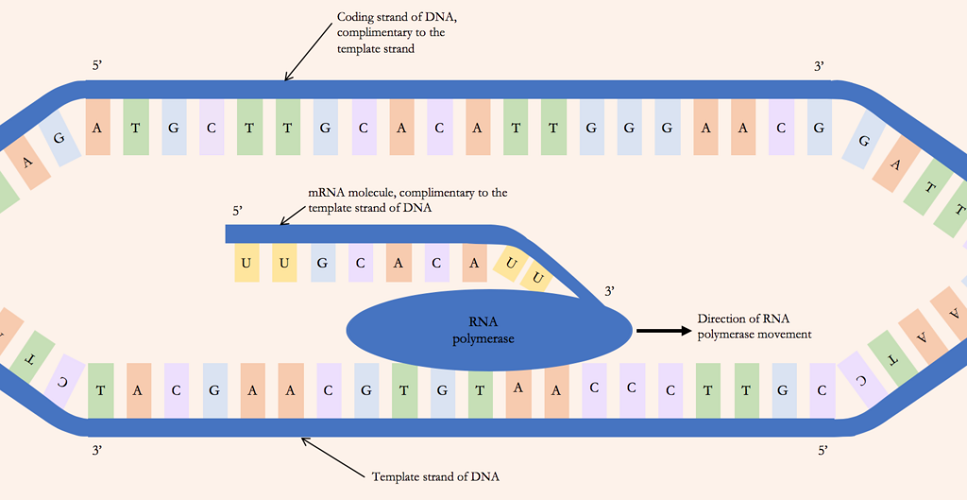
Elongation
The next phase in the transcription process is elongation. With the coded sequence exposed, RNAPs can read each individual adenine, guanine, cytosine, or thymine base on the template strand and connect the correct partner base to it. It is important to remember that RNA is unable to replicate thymine and replaces this with the nucleobase known as uracil.
If, for example, a short DNA sequence on the template strand is represented by C-A-G-T-T-A or cytosine-adenine-guanine-thymine-thymine-adenine, RNAP will connect the correct partner bases obtained from populations of free-floating bases within the nucleus. In this example, RNA polymerase will attach a guanine base to cytosine, uracil to adenine, cytosine to guanine, and adenine to thymine to form a strand of messenger RNA with the coded nitrogenous base sequence G-U-C-A-A-U. This process repeats until the RNAP enzyme detects a sequence of genetic code that terminates it – the terminator.

Termination
When the RNAPs detect a terminator sequence, the final phase of transcription – termination – takes place. The string of RNAPs disconnect from the DNA and the result is a strand of messenger RNA. This mRNA carries the code that will eventually instruct tRNA which amino acids to bring to a ribosome.
Messenger RNA leaves the nucleus via nuclear pores primarily through diffusion but sometimes needs help from transporter enzymes and ATP to reach its destination.
Translation Process in Protein Synthesis
During the translation process, the small and large subunits of a ribosome close over a strand of mRNA, trapping it loosely inside. Ribosomes arrange the strand into codons or sets of three nitrogenous base letters. This is because the code for a single amino acid – the most basic form of a protein – is a three-letter nucleobase code.
As ribosomes recognize parts of code, we can say they understand it. The jumble of copied letters made during the transcription phase can be read and understood in the translation phase.

For example, GGU, GGC, GGA, and GGG code for the amino acid known as glycine. Most amino acids have multiple codes as this lowers the chance of mistakes – if RNA polymerase accidently connects adenine instead of cytosine to GG, it doesn’t matter. Both GGC and GGA code for the same amino acid. You can see a list of mRNA codons for the twenty non-essential amino acids here.
There is only one start codon code – AUG. Three codons – TAA, TAG, and TGA – represent stop codons. Neither start nor stop codons match the code for an amino acid; they are non-coding. The single start and three stop codons are clearly marked on this codon wheel.

When a codon becomes visible – once the previous codon has been linked to an amino acid – a section of a transfer RNA molecule fits into the mRNA codon. This ‘key’ is called the anticodon. Transfer RNA has two roles – to attach to an amino acid outside of the ribosome and to deploy this amino acid at the right time and in the right position on an mRNA strand within the ribosome.
Tens to thousands of transfer RNA molecules produce a polypeptide chain. Titin or connectin is the largest protein molecule and contains around 33,000 amino acids. The smallest functional polypeptide is glutathione – just three amino acids. To produce glutathione, first the ribosome and tRNA must read the start codon (three bases), then read the first protein-coding codon (three bases), the second (three bases), the third (three bases), and the stop codon (three bases). The coding DNA and mRNA recipes (sequences) for glutathione contain nine bases. There may or may not be additional sections of non-coding DNA within this recipe. Non-coding sequences do not produce amino acids.
As with the process of transcription, translation within the ribosome is also split into the three stages of initiation, elongation, and termination.

Initiation involves the recognition by the ribosome of the mRNA start codon. Elongation refers to the process whereby the ribosome moves along the mRNA transcript, recognizing and exposing individual codons so that tRNA can bring the right amino acids. The anticodon arm of tRNA attaches to the appropriate mRNA codon under the influence of ribosomal enzymes.
Finally, termination occurs when the ribosome recognizes the mRNA stop codon; the completed polypeptide chain is then released into the cytoplasm. It is sent wherever it is needed – inside the cell or to other tissues, exiting the cell membrane via exocytosis.
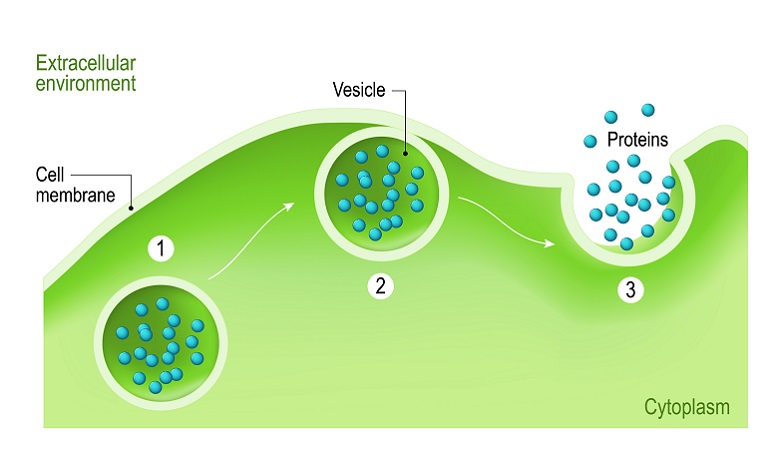
Quiz
